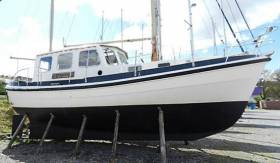Displaying items by tag: Rogger 36
Rogger 36 Sailing Cruiser For Sale is A World of Her Own
Although the current spell of good weather might well get you thinking of the need for biminis, shades and sunhats, don’t forget that only a couple of days ago we were in glowery damp conditions, when boats with a proper deck saloon and oodles of shipboard comfort provided by generous displacement margins were at a premium writes W M Nixon. And for those of us who yield to no-one in admiration of the Dutch as a sensible seafaring nation, this recent listing from Crosshaven Boatyard on Afloat Boats for Sale of a classic Rogger 36 ketch-rigged motor-sailer brings a very attractive boat centre-stage.
Oh for sure, she’s all of 37–years–old, and in days of yore when a wooden boat got to three decades-plus, you would be quite right to examine the proposition very carefully. But this glass fibre stuff, of which some were so dismissive back in the day (who now remembers the alleged existence of the polyester-mite?) has certainly proven itself a remarkably durable and robust material. And when you have a boat from Crosshaven, where they are conveniently able to provide regular drying-out periods ashore, the healthy longevity of basically sound GRP construction is a wonder to behold.
As the photo-tour shows, the accommodation makes excellent use of the full-bodied hull. You could if you wished sleep six on board, but she’s very comfortable for four and luxurious for two or three, and that deck-saloon/wheelhouse really does the business of allowing those in it to see the view while enjoying protection from the elements. As to performance, although she’s towards the “motor” end of the motor-sailer continuum, with a brisk breeze she can give a remarkably good account of herself, and of course when making progress on passage in a seaway, the experienced skipper well knows how to make best use of the motor-sailing combination to maximize progress while minimising motion.
The key to it all is a reliable diesel, and in this case it’s the original Perkins 4236 72hp motor. But for 2016 she comes to the new season with a completely re-furbished gearbox, and the engine itself is good for many years yet. The competitive price of €44,000 reflects both the boat’s age and the fact that in one or two areas she would benefit from a discerning bit of TLCD. But overall, with her handsome sheerline this is one very attractive proposition for seaferers who want to get out and about in our Irish weather.
See the full advert on Afloat boats for sale here





























































